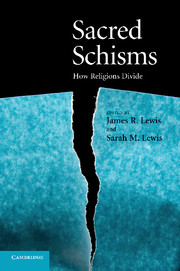Book contents
- Frontmatter
- Contents
- List of figures
- Notes on contributors
- Acknowledgments
- Introduction
- PART I THEORETICAL OVERVIEW
- PART II SURVEY OF SCHISMS IN SELECTED TRADITIONS
- PART III CHRISTIAN TRADITIONS
- PART IV WESTERN ESOTERIC TRADITIONS
- 8 Church Universal and Triumphant: shelter, succession and schism
- 9 Schism and consolidation: the case of the theosophical movement
- 10 Satanists and nuts: the role of schisms in modern Satanism
- 11 Schism as midwife: how conflict aided the birth of a contemporary Pagan community
- PART V NON-WESTERN/POSTCOLONIAL TRADITIONS
- Index
- References
11 - Schism as midwife: how conflict aided the birth of a contemporary Pagan community
Published online by Cambridge University Press: 24 October 2009
- Frontmatter
- Contents
- List of figures
- Notes on contributors
- Acknowledgments
- Introduction
- PART I THEORETICAL OVERVIEW
- PART II SURVEY OF SCHISMS IN SELECTED TRADITIONS
- PART III CHRISTIAN TRADITIONS
- PART IV WESTERN ESOTERIC TRADITIONS
- 8 Church Universal and Triumphant: shelter, succession and schism
- 9 Schism and consolidation: the case of the theosophical movement
- 10 Satanists and nuts: the role of schisms in modern Satanism
- 11 Schism as midwife: how conflict aided the birth of a contemporary Pagan community
- PART V NON-WESTERN/POSTCOLONIAL TRADITIONS
- Index
- References
Summary
Contemporary Paganism – which consists of Wicca and Witchcraft, Druidry, Heathenry, Asatru, Goddess-worshipers, Ethnic Reconstructionists, and many other traditions – is a movement that is still young and establishing its identity. The members of the movement confront a paradox of wanting to grow and unify, but also of wishing to maintain its characteristic diversity of traditions, identities, and rituals. Not surprisingly, the modern Pagan movement has had a restless and schismatic formation period, especially in the United States, running the gamut from splits based on interpersonal conflicts to the equivalent of denominational breaks brought on by theological differences and issues with organizational structures (Adler 1986; Berger 1999; Clifton 2006; Davies and Lynch 2001; Hopman and Bond 1996; Magliocco 2004; Pike 2001; Salomonsen 2002).
In some ways, the nature of contemporary Paganism – polyvalent, syncretic, and innovative – is set up to incorporate the splitting, renaming, and reforming that appears to characterize the movement; Gerald Gardner, the founder of Wicca, made room for and established guidelines of conduct in his tradition for the eventual and inevitable “hiving off” of coven members to form other groups (Adler 1986; Gardner 1954; Hutton 1999). Modern Pagans' ambivalence toward formal institutionalization, rejection of homogeneity, and embracing of a fluid, permeable and diverse identity within their membership can be argued, in some way, to contribute toward frequent schisms, but as time has passed, and definitions of what constitutes Pagan identity, practice, and community have shifted and drifted, hiving and splitting are being perceived less as a problem plaguing a movement, and instead are now accepted more as a necessary process if the fundamental Pagan value of diversity in the community is to be maintained (Magliocco 2004; Pike 2001; Salomonsen 2002).
- Type
- Chapter
- Information
- Sacred SchismsHow Religions Divide, pp. 248 - 262Publisher: Cambridge University PressPrint publication year: 2009



